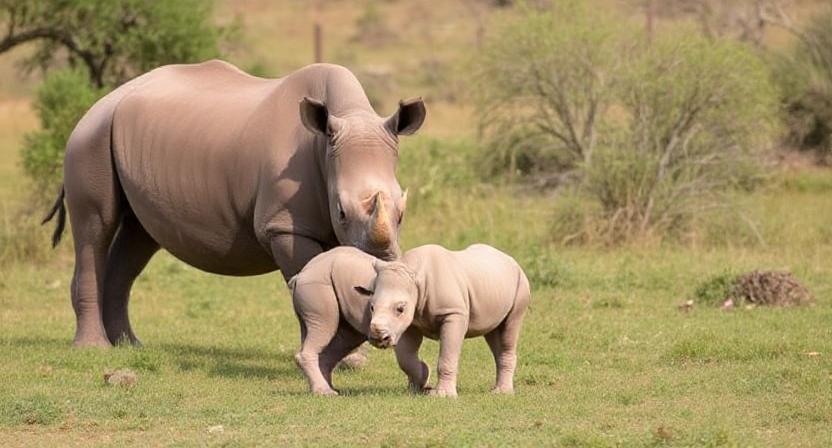Published on
November 1, 2025

African Parks has marked another great achievement in Rwanda’s effort to conservation through the birth of first rhino calf at the Akagera National Park. The arrival of the calf has been seen as a signal for successful restoration of wildlife in the park, after the translocation of 70 white rhinos that happened in June 2025, and is likely to boost the tourism sector in Rwanda. The birth of the calf is a big step in the many-year efforts toward the restoration of endangered species in Rwanda’s protected area, contributing to the country’s sustainable tourism and eco-tourism development.
A Milestone for Rwanda’s Wildlife and Tourism Growth
The birth of the white rhino calf is the first major milestone in the ongoing efforts to restore rhino populations to Akagera National Park, which had been extinct in the area for decades. This achievement reinforces Rwanda’s commitment to biodiversity conservation and enhances the country’s tourism offerings, particularly in the eco-tourism sector. The success of the white rhino project is expected to increase tourist arrivals, making Akagera one of the premier wildlife tourism destinations in East Africa.
The arrival of the white rhino calf signals that Akagera’s wildlife population is thriving in its new environment, and the park is now home to a growing rhino herd. This marks a significant achievement for Rwanda, which is positioning itself as a leader in African wildlife conservation and eco-tourism. The country’s focus on preserving iconic species and protecting natural habitats has been instrumental in attracting international visitors who seek sustainable travel experiences.
Tourism Boost and Community Benefits
The birth of the rhino calf is expected to boost tourism to Akagera National Park, drawing more wildlife enthusiasts, safari tourists, and adventure seekers to the region. As the park’s rhino population grows, tourists will have the opportunity to witness rhino sightings during safaris in the park, along with other iconic African wildlife, including lions, elephants, giraffes, and buffalo.
This growth in tourist interest will have a positive economic impact, providing employment opportunities for local communities in guiding services, hospitality, and tourism-related businesses. Additionally, the park’s conservation efforts help empower local people by offering them sustainable livelihoods linked to wildlife tourism. The park’s community engagement programs ensure that tourism growth is inclusive and beneficial to the local population, supporting both conservation goals and local economic development.
Promoting Rwanda’s Reputation as a Global Eco-Tourism Destination
The white rhino calf’s birth is another step toward strengthening Rwanda’s position as a leading eco-tourism destination in Africa. Rwanda’s tourism sector has been growing steadily, with the country becoming increasingly recognized for its commitment to sustainable tourism and wildlife conservation. Alongside gorilla trekking in Volcanoes National Park, Akagera National Park is emerging as a must-visit destination for wildlife lovers seeking to experience the beauty of Rwanda’s natural landscapes and its unique wildlife offerings.
Rwanda’s wildlife tourism industry continues to attract a growing number of international travelers, many of whom are drawn to the country’s focus on eco-friendly travel and conservation tourism. The white rhino’s reintroduction to Akagera is a testament to Rwanda’s successful conservation strategies and its growing appeal as a sustainable travel destination.
Collaborative Conservation Efforts in Rwanda
The success of Akagera’s rhino project is a result of collaborative efforts between Rwandan authorities, African Parks, and local stakeholders. The Rwandan government, along with African Parks, has played a pivotal role in the rhino translocation process, ensuring the safe introduction of white rhinos to the park. The project has received support from international conservation organizations, which have helped fund the reintroduction process and provided expertise in wildlife management.
Rwanda’s commitment to wildlife conservation and sustainable tourism is reflected in its ongoing efforts to expand protected areas and enhance tourism infrastructure. The government has introduced policies to promote eco-tourism while safeguarding Rwanda’s biodiversity, ensuring that tourism development aligns with environmental sustainability and local empowerment.
Looking Ahead: Expanding Wildlife Conservation and Tourism in Akagera
The birth of the white rhino calf is just the beginning for Akagera National Park’s wildlife restoration efforts. As the rhino herd continues to grow, the park plans to introduce other endangered species, such as the black rhino and cheetahs, further enhancing its wildlife offerings and attracting even more safari tourists. The growing rhino population will not only contribute to local biodiversity but will also play a critical role in promoting Rwanda’s eco-tourism as a major tourist attraction in East Africa.
The park’s sustainable tourism model is set to continue evolving, focusing on community-based tourism and conservation education for visitors. By integrating local communities into the tourism value chain, Akagera is working to create a sustainable model where tourism and conservation can thrive together, benefiting wildlife, local economies, and global travelers.
Akagera’s Role as a Leading Wildlife Tourism Destination
The birth of the white rhino calf at Akagera National Park is considered one of the most historic achievements in both Rwanda’s wildlife conservation efforts and its tourism sector. In fact, with an ever-increasing population of rhinos within the park, tourism in this region is bound to increase, thus fueling economic growth, community empowerment, and environmental sustainability. As conservation has successfully been integrated with tourism, Akagera serves as a model for sustainable tourism in Africa and attracts nature-based travelers, eco-tourists, and people interested in the conservation of wildlife. Going forward, Rwanda is poised to retain its status among the premier African destinations for wildlife tourism if wildlife conservation and eco-tourism development receive continued support.
link

